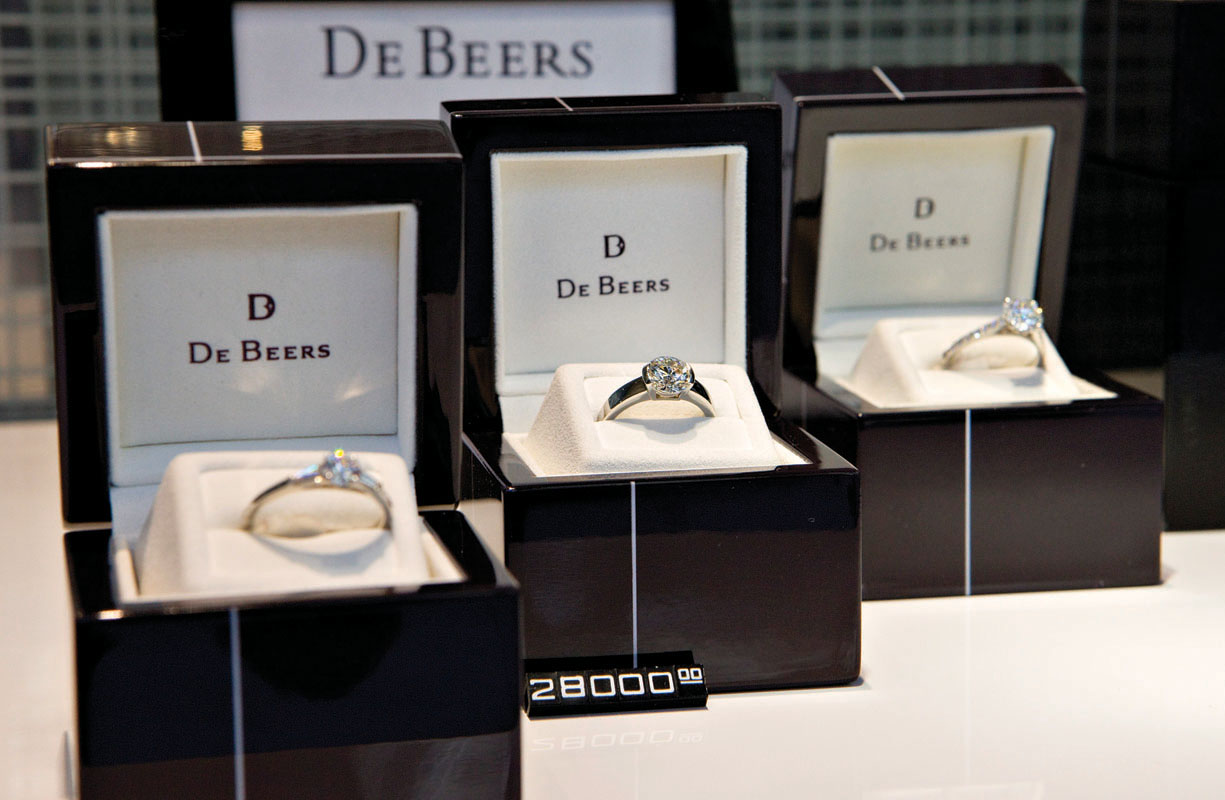!world! BUSINESS CASE: Newly Emerging Markets: A Diamond Monopolist’s Best Friend
When Cecil Rhodes created the De Beers monopoly in 1888, it was a particularly opportune moment. The new diamond mines in South Africa dwarfed all previous sources, so almost all of the world’s diamond production was concentrated in a few square miles.
For almost a century, De Beers was able to extend its control of resources even as new mines opened. De Beers either bought out new producers or entered into agreements with local governments that controlled some of the new mines, effectively making them part of the De Beers monopoly. The most remarkable of these was an agreement with the former Soviet Union, which ensured that Russian diamonds would be marketed through De Beers, preserving its ability to control retail prices. De Beers also went so far as to stockpile a year’s supply of diamonds in its London vaults so that when demand dropped, newly mined stones would be stored rather than sold, restricting retail supply until demand and prices recovered.

Daniel Acker/Bloomberg via Getty Images
However, the De Beers monopoly has been under assault. Until the 1980s, De Beers accounted for 90% of all rough diamond sales. Today, that share has dropped to about 40%, courtesy of dramatic changes in the industry.
Government regulators have forced De Beers to loosen its control of the market. For the first time, De Beers has competition: a number of independent companies have begun mining for diamonds in other African countries, including Alrosa, a Russian-based mining company, BHP Billiton of Australia, and Anglo-Australian mining group Rio Tinto. The growing market share of these companies has helped to erode De Beers’s dominance. In addition, high-quality, inexpensive synthetic diamonds have become an alternative to real gems, eating into De Beers’s profits. So does this mean an end to high diamond prices and De Beers’s high profits?
Not really. Although today’s De Beers is more of a “near-monopolist” than a true monopolist, it still mines more of the world’s supply of diamonds than any other single producer. And it has been benefiting from newly emerging markets. Consumer demand for diamonds has soared in countries like China and India, leading to price increases.
Although the economic crisis of 2009 put a serious dent in worldwide demand for diamonds, forcing De Beers to cut production by 20% (compared to 2008), affluent Chinese continue to be heavy buyers of diamonds. In fact, in 2011, China surpassed Japan to become the biggest diamond-consuming nation behind the United States. Buyers in China and India made up about 20% of global demand in 2011, and estimates are that number will rise to 28% in 2016. De Beers is anticipating that Asian demand will accelerate the depletion of the world’s existing diamond mines. As a result, diamond analysts predict rough diamond prices to rise by at least 6% per year through 2020.
In the end, although a diamond monopoly may not be forever, a near-monopoly with rising demand in newly emerging markets may be just as profitable.
Question
D+YjR2eg/tu3vVo++5TFpgkZSaWa6jIbprSBR5B+un4SNST2pIKis1XxZeUG8trGj8JShUNi9iOsg72yj/KEra38rsbWY+3jCiirz9lnvVJLWBLZye1iPqH23dKe1nXO5zXN5C36SBEkKpjRl6IloXuY3rp0wOX45aEkrU2P/y7EV+7vKQQ5noJx2n6mr9e/F4R7NOmX0iky4cgbVQGe3dhJvHLMQ+yLcfWvzRU2Trvql6uUL8FXEqzNb6jq5hwZBzBvkIcVaiSWnjSyGF75ipf2Wa3fampONbbanXWPbe2cn+mjm2GRpy/zYttu5Pp5m15miKsmxYG6e+CcWhat will happen to the demand for De Beers’s diamonds when consumers start seeing high-quality, inexpensive synthetic diamonds as a substitute? Explain.
Question
+ijM4YTZV3nPb6i3lITJFOKEwBKVpiNWQVJUp4HLIh8DDP58iHJyfu/rSGuCtpz8UccNe0LnwtjevC5NuSijK1zSdQm3dhiSbMQnCj/wK0KH7bOTMCPmHTeIEAqJCyY7iXIwOuiGSW8Q5T4GM8v9X3q3AvNbgK1igM6W7Vw8/URAT35YjVZ7iPFQ7BqeENfSFhW9z9eRqmUfgxJGQo+l/dmVSZ8S+NUp2wMg190sF9wY3vihZIhF1Jd+kd7SzyeQ9CJgCNjJxSyG/JCkFhd+egIxAq42GM5K4ebwppI7vnjft77BQvk5aQuMldd776iVsODRAeCJ+HXpvZgLh+Lx2RXEc6A=Using the concept of monopoly profits, explain what would happen if demand for De Beers’s diamonds decreases. Also explain what would happen to the market price and market quantity of De Beers’s diamonds.
Question
a5UJMS1BDjpm9Zp7g3LcIZaLiuA6L6Xv2WWhiqL10jgpv2kpcqEaLe+ym2DGsFHgNhirObDEY4YbjMoR0pyWnMC3VWdMuINTr0bMHD+7jtwK0vbcvhllqipHISCHj0f0J4gydx5Hwn+ECQktrCaivE2dMoi86MHAk4qkQ5jIl2wYYV7cJ4JjzdO6MnMw604B7StdvsJt6ysMyPUa4Ys/9HRsfqT8U4SBu7qCQ8Sx2d5C0aWJlBSJdFzJHCZfpsCHuQZgoRtouc816vSlVigkk4SyocI=What effect will the market entry of other diamond-mining firms have on the extent of De Beers’s market power?
Question
eegMp7JJJh6iF2s0fe53jN6mf0oxuLwicGoyD4GpLmkOOL7IYK8ZORHDclspcrY0EJ01mc/VVbiIY4T5NFpvu1+lmiHYWfSYMtbSLa/bGD9UOXDqfSXvQkLEeJ90f83yo4gsrrWDiZslQZ+L3bY9bGfmslYyd05NOkNdHieVLR8Embyc16BBG6atucMvISL3j7RbO5yTBjT8QinaiT4yOU+xi7j1z2hjj+ZQOlA6eiOEjXGlstFbt4Zoy/J7E8bntl5MSSuSRP6rywG+CCIIxBeZfszZk0PmUJS/HvLaE1g6YkV7uhjfIS5Z96lWKU50dwc9AdyinxCjA5QYESilZGkocAg19fArpBRJPMCFw9sYPIqlGiven that the depletion of existing diamond mines will make it more costly to produce (mine) diamonds, draw a graph to illustrate the effects of this development on De Beers’s prices and quantities. Explain your findings.
